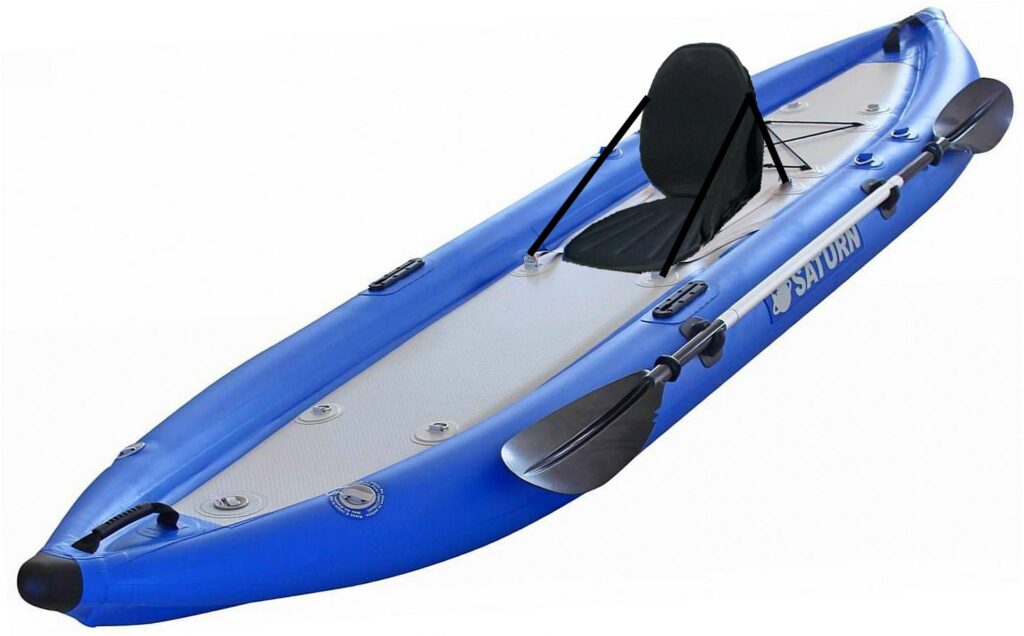A typical inflatable kayak weighs approximately 30 pounds. An inflatable kayak can weigh anywhere from under 20 pounds for an inexpensive model to well over 50 pounds for more durable and reliable options.
Finding Your Perfect Fit The weight of an inflatable kayak depends on the quality of construction, materials used, and size when inflating an inflatable kayak. Choosing the right weight is crucial for portability, stability, and intended use. To learn more about how heavy is an inflatable kayak & selecting the perfect inflatable kayak weight for your needs, read on.
Average Weight Range Of Inflatable Kayaks
Inflatable kayaks are a great choice for anyone who loves to be on the water. They are like air-filled boats that you can pack and carry around easily. Let’s find out how heavy is an inflatable kayak.

Light Inflatable Kayaks
- Weight Range: 20-30 pounds
- Best for: Solo paddlers, easy transport
- These kayaks are super light. You can pick them up with one hand! They’re perfect for one person and can be carried to the water without any help.
Medium Inflatable Kayaks
- Weight Range: 30-40 pounds
- Best for: Solo or tandem use, longer trips
- A bit heavier, these kayaks are still easy to carry. They have more room and can hold two people. This makes them great for adventures with a friend.
Heavy Inflatable Kayaks
- Weight Range: 40-50 pounds
- Best for: Fishing, heavy-duty use
- The heaviest of the bunch, but still not too hard to move. These kayaks are tough and can be used for fishing. They have space for gear and are very sturdy on the water.
Inflatable kayaks come in different weights, but all are made to be easy to carry. Whether you’re going alone, with a friend, or planning to catch some fish, there’s an inflatable kayak that’s just right for you.
Factors Influencing The Weight Of Inflatable Kayaks
When we talk about how heavy or light an inflatable kayak is, a few things come into play. It’s like when you pack your backpack for school; the more books you add, the heavier it gets. Let’s see what makes some kayaks heavier than others.
Material Used
- Types of Materials: PVC, Nitrylon, and Polyurethane
- Impact: Thicker materials make the kayak heavier but more durable.
- The stuff the kayak is made of can change its weight. Thicker, tougher materials make the kayak a bit heavier, but they also make it strong and able to last longer.
Size of the Kayak
- Length and Width: Bigger kayaks weigh more.
- Impact: More material means more weight.
- Just like a larger backpack can hold more books, a bigger kayak uses more material, which adds to its weight. Larger kayaks offer more space but are heavier.
Added Features
- Examples: Seats, storage, footrests
- Impact: More features add extra weight.
- Think of these features like the extra pockets and zippers on a backpack. They’re super useful but add a little more weight. Kayaks with lots of added features like comfy seats and places to store your gear will be heavier.
Understanding what affects the weight of an inflatable kayak can help you choose the right one. Whether you want something light and easy to carry or a bit heavier with more features, there’s a kayak out there for you.
The Impact of Weight on Performance and Transportability
The weight of your inflatable kayak affects two big things: how it moves in the water and how easy it is to carry around. It’s like when you wear a heavy backpack, it’s harder to run fast, but a light backpack makes moving easier. Let’s dive into how the weight of a kayak changes things.
On the Water Performance
- Lighter Kayaks: Easier to maneuver and faster.
- Heavier Kayaks: More stable and can handle rougher waters.
- Imagine your kayak is a leaf floating on a pond. A lighter leaf moves quickly with a little breeze but can flip over easily. A heavier leaf moves slower but stays steady even when the water gets choppy. Lighter kayaks are nimbler, but heavier ones are steadier.
Transporting the Kayak
- Light Kayaks: Easy to carry and load on a car.
- Heavy Kayaks: Might need a cart or extra help to move.
- Think about carrying your school bag. If it’s light, you can easily pick it up and run. But if it’s packed full, you might need help lifting it. A light kayak is a breeze to carry to the water, but a heavy one might need a special cart or a friend to help.
Is A Lighter Or Heavier Kayak Better?
Whether a lighter or heavier kayak is better depends on your needs. Lighter kayaks are easier to transport and maneuver, ideal for calm waters and short trips. Heavier kayaks offer more stability and inflatable kayak durability, better suited for rough waters and longer expeditions. Choose based on your activities and preferences.
Weight plays a big role in how your kayak acts on the water and how simple it is to take it places.

Choosing the Right Inflatable Kayak Based on Weight
Picking the right inflatable kayak is a lot like choosing the best backpack for school. You need one that fits everything you want but isn’t too heavy to carry. The weight of the kayak is important because it affects how you use it. Let’s figure out how to choose the best one for you.
Consider Your Activities
- For Quick Trips: Choose a lighter kayak.
- For Adventure or Fishing: A heavier kayak might be better.
- If you’re planning to zip around for a short while, a light kayak is perfect. It’s easy to move and fun to paddle. But if you’re going on big adventures or want to fish, a heavier kayak with more features will be your friend.
Think About Transport
- If You’re Walking to the Water: Light kayaks are easier.
- If You’re Driving: Weight might not matter as much.
- How you get your kayak to the water changes what’s best. If you have to carry it a long way, a lighter is better. But if you can drive right up to the water, a heavier kayak isn’t a big deal.
Match the Kayak to Your Strength
- Know Your Limits: Choose a kayak you can comfortably carry and handle.
- It’s important to pick a kayak that you can lift and carry by yourself or with a little help. This makes going kayaking fun and not a chore.
Picking the right inflatable kayak means thinking about what you’ll do with it, how you’ll get it to the water, and making sure it’s not too heavy for you.
Closing Words
Knowing “how heavy is an inflatable kayak” is key to finding your perfect portable match for water adventures. Whether you prioritize speed, stability, or ease of transport, the right inflatable kayak’s weight makes a big difference in your experience. Choose wisely and enjoy the freedom and fun on the water.
FAQs
Kayaks vary in weight, but most single kayaks weigh between 9 kg (20 lbs) to 36 kg (80 lbs), and tandem kayaks can weigh more.
A kayak is too heavy if it impedes transport, launch, or retrieval by the user, generally above 36 kg (80 lbs) for single models.
Yes, heavier kayaks tend to be more stable in the water due to their increased weight distribution and lower center of gravity.
Heavier kayaks can be slower because the extra weight increases drag in the water, requiring more effort to paddle and maintain speed.
A lightweight kayak typically weighs between 9 kg (20 lbs) and 18 kg (40 lbs), making it easier to carry and paddle.




